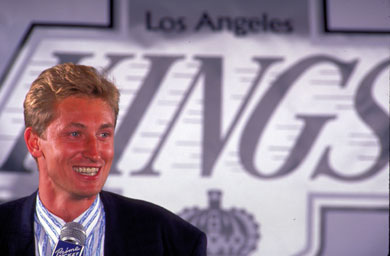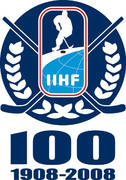Story #86
EDMONTON, Canada – August 9, 1988
On the morning of August 10, 1988, the front page of the Edmonton Sun was, of course, devoted to the shocking news. The lone headline was: "99 tears". At the bottom of the page, below the photo of a young man crying, was added: More on pages: 2, 3, 4, 5, 6, 10, 11, 18, 19, 23, 30, 36, 37, 38, 39, 40, 41, 42, 43, 46, 47.
Was this World War III? Did a man land on Mars? Had Canada defeated Brazil in the FIFA World Cup final? None of the above. Edmonton jewel and Canadian national treasure, hockey player Wayne Gretzky, was going to play in the United States. No, Gretzky wasn't getting long in the tooth. He was only 27. No, he wasn't slowing down. The best player in the world had just a couple of months earlier led the Oilers to their fourth Stanley Cup in five years and Gretzky had amassed an amazing 149 points despite missing 16 regular-season games to injury.
Did the Oilers get Taj Mahal in return? Not really. Two pretty average players plus three first round draft choices and $15 million. All this wasn't even close to reflecting Gretzky's sportive and marketing value.
Hockey people from Turku, Finland, through Ostrava, Czechoslovakia to Togliatti, Soviet Union were asking: "Why"? On the morning of August 10 "The trade" was headline news on all radio shows in Europe, even in countries where hockey was a marginal sport. Global publications such as the International Herald Tribune, which only occasionally gave hockey any attention, devoted prime space to the deal. The answer to the question was two-fold: (a) it showed that professional hockey is, after all, a business; (b) it set a benchmark which now announced that no player could anymore be considered untouchable.
To the hockey world that knew number 99 from the 1978 World Juniors, the 1981, 1984, and 1987 Canada Cups, and the 1982 World Championship (he led each of the aforementioned tournaments in scoring), Gretzky was what Pelé and Maradona were to soccer and what Magic Johnson or Larry Bird were to basketball. He was the sport. He personified it; he represented it; he promoted it through excellence on ice and commitment off it.
The trade eventually had implications on the NHL's expansion as Gretzky's move to California paved the way for a second and third franchise in that state (Anaheim and San Jose). In 1993, the same year Gretzky led the Kings to the Stanley Cup finals, Anaheim entered the league, and, ironically, when the Stanley Cup was won by a California team for the first time, in 2007, it was Anaheim. All because of the trade of the century.
As part of the IIHF's 100th anniversary celebrations, www.IIHF.com is featuring the 100 top international hockey stories from the past century (1908-2008). Starting now and continuing through the 2008 IIHF World Championships in Canada, we will bring you approximately three stories a week counting down from Number 100 to Number 11.
The Final Top 10 Countdown will be one of the highlights of the IIHF's Centennial Gala Evening in Quebec City on May 17, the day prior to the Gold Medal Game of the 2008 World Championship.
These are the criteria for inclusion on this list: First, the story has to have had a considerable influence on international hockey. Second, it has to have had either a major immediate impact or a long-lasting significance on the game. Third, although it doesn't necessarily have to be about top players, the story does have to pertain to the highest level of play, notably Olympics, World Championships, and the like. The story can be about a single moment — a goal, a great save, a referee's call — or about an historic event of longer duration — a game, series, tournament, or rule change.
|
 |
Click here for the 100 Top Stories
|










